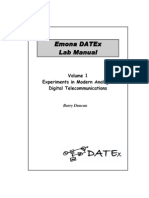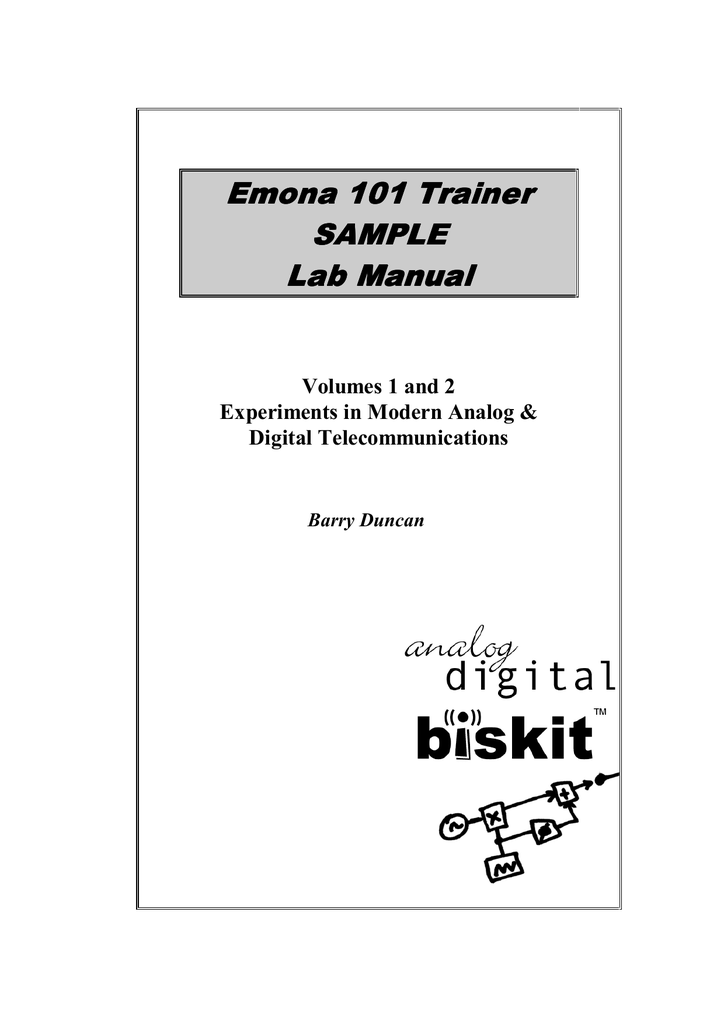Emona Telecoms Trainer 101 Lab Manual Pdf
The Emona Telecom’s-Trainer 101, ETT-101, is one of a number of Emona’s specialist telecoms laboratory teaching tools. The EET-101 is designed for technical college and high school labs where telecoms is first introduced. The role and applications of computer laboratory projects to involve students in more intense problem-solving experience. This availability also provides an opportunity to easily conduct numerical experiments and to tackle realistic and more complicated problems. Originally, the manual is divided into computer laboratory sessions (labs). Course 101 Broadband, Telecom, Datacom and Networking for Non‑Engineers is our core training, representing the knowledge set needed by anyone in telecom today. The content, its order, our analogies and explanations have been refined over the course of more than twenty years and totally updated for the 2020s.
- Emona Telecoms Trainer 101 Lab Manual Pdf Free Jet Online
- Emona Telecoms Trainer 101 Lab Manual Pdf Form
- Emona Telecoms Trainer 101 Lab Manual Pdf Gratis
TIMS-301/C
Advanced Lab Teaching – TIMS 301/C
TIMS helps students by simplifying complex principles and coding schemes in telecommunication through this flexible and versatile communications Trainer to give students an inspiring hands-on learning experience....
Read MoreETT-101 BisKIT
Compact Experimenter – BiSKIT 101
BiSKIT makes teaching telecommunications much easier for professors, in introductory university and technical college courses. Performs around 70 experiments using the unique block diagram approach...
Read MorenetTIMS FreeWire
Basic Telecoms Online Labs
net TIMS FreeWire offers real TIMS experiments delivered online simultaneously to multiple students across LAN & Internet in real-time. No setup required by the Professors. All experiments included in the Control unit, which students can then access and control from within the lab and at a distance, to carry out the experiments.
Read Morenet*TIMS
Advanced Telecoms Online Labs
net*TIMS allows professors to set-up real TIMS telecommunications experiments in their own laboratory, which students can then access and control from within the lab and at a distance, to carry out the experiments.
Read MorenetCIRCUITlabs
net CIRCUIT labs – Analog & Digital Electronics Circuits
netCIRCUITlabs delivers real-time control and measurement of real electronics circuits online to multiple students, simultaneously, 24/7, via LAN and the Internet. 25 or more simultaneous students per Server, with each student accessing any experiment on the APPLICATIONS board.
Read MoreCloudTIMS
Hardware Experiments Subscription Service
The experiment equipment is located at Emona’s Sydney offices, in Australia. Students access these real hardware experiments from their web browser, from anywhere, 24x7.
Read MoreTUTOR TIMS
Emona Telecoms Trainer 101 Lab Manual Pdf Free Jet Online
TIMS Telecoms Simulation Software
Students can create their own experiments or load up the pre-prepared experiments at home before and after attending the lab, and have real-time, hands-on experience with the hardware...
Read MoreMulti-experiment Single Board Telecoms Trainer for the popular NI ELVIS™ platform
Designed specifically for 1st & 2nd Year University and Community College courses
- Emona Telecoms-Trainer 202, known as DATEx, plugs into the NI ELVIS™ platform, operating in local mode and under LabVIEW™
- An excellent “hands-on” experiment system, implementing the well established “block diagram approach” to building
- Supported by a comprehensive Lab Manual written for younger students in introductory classes
- Unrivalled with a wide range of modern communications topics in one compact trainer
- Local control and also remote control via the ETT-202 SFP virtual instrument on LabVIEW™
ETT-202 SFP virtual instrument on LabVIEW

DESIGNED FOR NI ELVIS™ The Emona Telecoms-Trainer 202 extends the functionality of your NI ELVIS™ platform and LabVIEW™ software with a plug and play telecommunications board to teach the fundamentals of modern communications theory.
Waveform displays and measurements are on-screen using LabVIEW™. Control is either via the front panel knobs and switches, or through the PC via the ETT-202 Soft Front Panel (SFP) instrument.
BLOCK DIAGRAM APPROACH
Using the ETT-202, students learn fundamental concepts by actually building telecommunications experiments at the block diagram level. Theory comes to life as they build the modulation and coding schemes in carefully guided steps.
Emona Telecoms Trainer 101 Lab Manual Pdf Form
Students are free to learn by trying “what-if” scenarios to investigate the telecommunications theory they learn in class. With the ETT-202, your students will learn more, and remember more.
COMPACT and EASY FOR TEACHERS
The system is completely self-contained: all that is required is the ETT-202, NI ELVIS™ and LabVIEW™ running on a PC.
The ETT-202 accessories kit includes:
20 x stackable patch cords, User Manual, Digital and Analog Basic Telecommunications Experiments Manual Volume-1 and the ETT-202 SFP CD-ROM.
ADDITIONAL EXPERIMENT CAPABILITIES
Given that the ETT-202 provides a wide array of fundamental electronic building blocks, controllable using LabVIEW™ , the ETT-202 can also be used as a general purpose applications board to investigate topics such as systems control and integration of LabVIEW applications with electronic hardware.
TELECOMMUNICATIONS TOPICS
Emona Telecoms Trainer 101 Lab Manual Pdf Gratis
- Basic Analog Communications AM, FM, DSB, SSB, PM, PAM, TDM, PWM, Superheterodyne, Speech in Comms, PLL, QAM, SNR Concepts and more
- Digital Communications PCM, PCM-TDM, ASK, BPSK, FSK, GFSK, Eye Patterns, DPSK, QPSK, Spread Spectrum, Line Coding, Noise Generation, SNR Concepts and more
- LabVIEW™ APPLICATIONS
- Familiarity with LabVIEW™ VI’s; Controlling real telecommunications signals and experiment set-ups via the DATEx Soft Front Panel; Utilising a suite of LabVIEW™ VI’s to generate, view and record real signals;
- System Control & Design Skills; Integrate hardware and software signal processing; Create ‘hardware in the loop’ systems; Data acquisition of real electrical signals; Writing new LabVIEW™ applications using DATEx function block VI’s
TELECOMMUNICATIONS TOPICS
- Basic Analog Communications AM, FM, DSB, SSB, PM, PAM, TDM, PWM, Superheterodyne, Speech in Comms, PLL, QAM, SNR Concepts and more
- Digital Communications PCM, PCM-TDM, ASK, BPSK, FSK, GFSK, Eye Patterns, DPSK, QPSK, Spread Spectrum, Line Coding, Noise Generation, SNR Concepts and more
- LabVIEW™ APPLICATIONS
- Familiarity with LabVIEW™ VI’s; Controlling real telecommunications signals and experiment set-ups via the DATEx Soft Front Panel; Utilising a suite of LabVIEW™ VI’s to generate, view and record real signals;
- System Control & Design Skills; Integrate hardware and software signal processing; Create ‘hardware in the loop’ systems; Data acquisition of real electrical signals; Writing new LabVIEW™ applications using DATEx function block VI’s
View a brief
7 minutes video presentation
ABOUT Datex
.
LABORATORY MANUAL
The ETT-202 Laboratory Manual set (Vol.1, 2 & 3) provides a turn-key solution for the teacher and student alike.
ETT-202 Laboratory Manual
It is specially written to guide students through hands-on experiments and help them grasp the fundamental concepts of telecommunications.
Each chapter includes background information which relates the experiment content to real-world applications. Since telecommunications text books represent the math and concepts of telecommunications theory as “block diagrams” this Lab Manual makes extensive use of block diagrams throughout.
Associated with each block diagram are detailed, step-by-step patching diagrams. Each chapter is carefully paced and constant use is made of questions to verify the student’s understanding and provide feedback to the teacher.
LAB MANUAL TOPICS – VOLUME 1 (300 pages) ETT-202 Experiment Phase
- Setting-up an Oscilloscope display
- An Introduction to the ETT-202
- Modelling Equations
- Amplitude Modulation AM
- Double Sideband DSB Mod
- AM Demodulation
- DSB Demodulation
- SSB Modulation & Demod
- FM Modulation
- FM Demodulation
- Sampling & Reconstruction
- PCM Encoding
- PCM Decoding
- BW Limiting & Restoring Digital Signals
- ASK Mod & Demodulation
- FSK Mod & Demodulation
- BPSK Mod & Demodulation
- QPSK Mod & Demodulation
- Introduction to Spread Spectrum – CDMA modulation
- Introduction to Undersampling in Software Defined Radio
LAB MANUAL TOPICS – VOLUME 2
- AM (method 2) and product detection of AM signals
- Noise in AM communications
- PCM and time division multiplexing (TDM)
- An introduction to Armstrong’s modulator
- Phase division modulation and demodulation
- Pulse width modulation and demodulation (PWM)
- Message translation and inversion
- Carrier acquisition using the phase locked loop (PLL)
- Signal to noise ratio and eye diagrams
- Pulse code modulation and signal to noise distortion ratio (SNDR)
- ASK demodulation using product detection
- FSK generation (switching method) and demodulation
- Principles of Gaussian FSK (GFSK)
- PN sequence spectra and noise generation
- Line coding and bit clock regeneration
LAB MANUALS TOPICS-VOLUME 3
- LabVIEW Control of DATEx Hardware Overview
- Using Prewired Backgrounds on the DATEx MAIN SFP
- Saving Screen Space with the DATEx ‘Toolbar’ SFP
- Low Level DATEx VIs
- Programming Amplitude Control Blocks
- Programming Frequency Control Blocks
- Programming Phase Control Blocks
- Programming Timing Control Blocks
- Programming Mode Control Blocks
- Sequencing and Combining the DATEx Blocks
- Using NI ELVIS Instruments on the DATEx
- Building LabVIEW Controlled DATEx Experiments
- Viewing filter responses using FFTs
- Introducing complex I/Q modulation using LV Modulation Toolkit
- Armstrong’s phase modulator using the LV Modulation Toolkit
- MSK modulation using the LV Modulation Toolkit
- FM generation using the LV Modulation Toolkit
- Further LabVIEW Programming Tasks
- Controlling DATEx remotely across the Internet
ANALOG BASICS
1. Amplitude Modulation (AM)
- modulation: 2 methods
- envelope detection
- product detection (coherent)
- AM in a noisy channel

2. Double Side Band (DSB)
- suppressed carrier
- product detection (coherent)
- DSB in a noisy channel
3. Single Sideband (SSB)
- generation only (upper & lower)

4. Phase Modulation (PM)
- Armstrong’s Phase modulator
5. Phase Division Modulation (PDM)
- Phase division demodulation
6. Frequency Modulation (FM)
- Generation by VCO (wideband)
- demodulation by PLL
- demodulation by zero crossing method
7. Pulse Amplitude Modulation (PAM)
- sampling theorem / Nyquist
- aliasing
- reconstruction
- time division multiplexing (TDM)
8. Pulse Width Modulation (PWM)
9. Speech and Audio messages
- message inversion
- message translation
10. Superheterodyne principles
DIGITAL BASICS
14. Pulse Code Modulation (PCM)
- encoding
- decoding & reconstruction
- sampling rate
- aliasing, undersampling and oversampling
- synchronization
15. Time Division Multiplexing (PCM – TDM)
16. Amplitude Shift Keying (ASK)
- modulation
- envelope recovery
- synchronous recovery
17. Binary Phase Shift Keying (BPSK)
- modulation/demodulation
18. Frequency Shift Keying (FSK)
- modulation
- envelope recovery
19. Introduction to GFSK
20. Pulse shaping
21. Data recovery in a noisy channel
22. Intersymbol Interference (ISI)
- eye patterns/diagrams
INTRO TO ADVANCED ANALOG
11. Carrier Acquisition using PLL

12. Signal to Noise Ratio (SNR) – Introduction to SNR
13. Quadrature Amplitude Modulation (QAM)
- modulation
- demodulation
INTRO TO ADVANCED DIGITAL
23. Differential Phase Shift Keying (DPSK)
- modulation/demodulation
24. Quadrature Phase Shift Keying (QPSK)
- modulation/demodulation
25. Spread Spectrum (SS)
- introduction to direct sequence spread spectrum (DSSS)

26. Line coding
- NRZ – L
- Alternate Mark Inversion (AMI)
- Manchester (Bi – phase)
- Differential encoding (NRZ – M)
27. Frequency Synthesis with PLL
28. PN sequence spectrum display
29. Noise generation
30. Introduction to Undersampling in Software Defined Radio
Additional Experiment Capabilities
- Introduction to Control Systems
- Using LabVIEW™ to control external electronic circuits